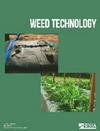加利福尼亚水稻中的小花伞形莎草(Cyperus difformis)、稗草(Echinochloa crus-galli)和胡子雀麦(Leptochloa fusca spp.
IF 1.7
3区 农林科学
Q3 AGRONOMY
引用次数: 0
摘要
加利福尼亚水稻田晚季杂草的出现使有关控制措施时机的决策变得复杂。本研究的目的是利用热时间模型预测水稻中三种问题杂草的出苗情况。2018 年,在萨克拉门托河谷水稻种植区的三个地点,每天对小花伞形莎草、稗草和胡枝子幼苗进行计数和清除。热时间(生长度日,GDD)的累积从每个地点的田地最初淹水开始,利用每个物种对应的特定基温。萌发模式与 GDD 的函数关系采用 Weibull 函数建模。比较实际累计出苗值和模型预测值的均方根值为 6% 至 23%。小花伞形莎草的累计出苗率最初迅速上升,累积 13 个 GDD 时出苗率达到 90%。稗草在小花伞形莎草之后出现,累积出苗率达到 90% 时的 GDD 为 124 个 GDD。与稗草相比,胡枝子萌发时间推迟了 64 GDD,在 215 GDD 时达到 90% 的萌发率。在所有田间地点,三种杂草的萌发期各不相同,导致杂草的萌发随时间不断变化。这项研究描述了三种具有重要经济价值的水稻杂草的出苗情况,为确定杂草管理的时间提供了有用的信息。通常在播种当天施用除草剂可能会降低对晚发杂草的药效,从而降低对杂草的控制效果。建议推迟施用除草剂、叠加残留除草剂或使用具有较长残留活性的除草剂来控制晚发杂草。本文章由计算机程序翻译,如有差异,请以英文原文为准。
Emergence Timing of Smallflower Umbrella Sedge (Cyperus difformis), Barnyardgrass (Echinochloa crus-galli), and Bearded Sprangletop (Leptochloa fusca spp. fascicularis) in California Water-Seeded Rice
Late-season weed emergence in California rice fields complicates decisions concerning the timing of control measures. The objective of this study was to predict the emergence of three problematic weed species in rice using thermal time models. Smallflower umbrella sedge, barnyardgrass, and bearded sprangletop seedlings were counted and removed daily at three locations across the Sacramento Valley rice-growing region in 2018. The accumulation of thermal time (growing degree day, GDD) commenced with the initial flooding of the fields at each location, utilizing the specific base temperatures corresponding to each species. The pattern of emergence as a function of GDD was modeled with a Weibull function. Root-mean-square values for comparing actual and model-predicted cumulative emergence values were 6 to 23%. Cumulative percent emergence initially increased rapidly for smallflower umbrella sedge and reached 90% emergence with accumulation of 13 GDD. Barnyardgrass emerged after smallflower umbrella sedge and reached 90% emergence with an accumulation of 124 GDD. Bearded sprangletop had a delay of 64 GDD compared to barnyardgrass to reach first emergence and reached 90% emergence at 215 GDD. The period of weed emergence at all field sites differed across the three species and led to a continuous spectrum of weed emergence over time. This study characterized the emergence of three economically important rice weeds and provided useful information for the timing of weed management. Typical herbicide applications on the day of seeding may have less efficacy on the late-emerging weeds, causing reduced weed control. Delaying herbicide applications, overlay of residual herbicides, or use of herbicides with longer residual activity are suggested to control late-emerging weeds.
求助全文
通过发布文献求助,成功后即可免费获取论文全文。
去求助
来源期刊

Weed Technology
农林科学-农艺学
CiteScore
2.90
自引率
21.40%
发文量
89
审稿时长
12-24 weeks
期刊介绍:
Weed Technology publishes original research and scholarship in the form of peer-reviewed articles focused on understanding how weeds are managed.
The journal focuses on:
- Applied aspects concerning the management of weeds in agricultural systems
- Herbicides used to manage undesired vegetation, weed biology and control
- Weed/crop management systems
- Reports of new weed problems
-New technologies for weed management and special articles emphasizing technology transfer to improve weed control
-Articles dealing with plant growth regulators and management of undesired plant growth may also be accepted, provided there is clear relevance to weed science technology, e.g., turfgrass or woody plant management along rights-of-way, vegetation management in forest, aquatic, or other non-crop situations.
-Surveys, education, and extension topics related to weeds will also be considered
 求助内容:
求助内容: 应助结果提醒方式:
应助结果提醒方式:


